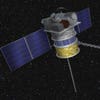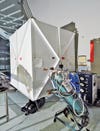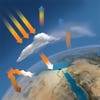Who Killed The Deep Space Climate Observatory?
Nearly a decade ago, NASA built an Earth-monitoring satellite that could have observed global warming in action. Then the agency stashed it in a warehouse in Maryland, where it remains to this day.

It all began so hopefully. Al Gore proposed the satellite in 1998, at the National Innovation Summit at the Massachusetts Institute of Technology. Gazing skyward from the podium, the vice president described a spacecraft that would travel a full million miles from Earth to a gravity-neutral spot known as the L1 Lagrangian point, where it would remain fixed in place, facing the sunlit half of our planet. It would stream back to NASA video of our spherical home, and the footage would be broadcast continuously over the Web.
Not only would the satellite provide “a clearer view of our world,” Gore promised, but it would also offer “tremendous scientific value” by carrying into space two instruments built to study climate change: EPIC, a polychromatic imaging camera made to measure cloud reflectivity and atmospheric levels of aerosols, ozone and water vapor; and NISTAR, a radiometer. NISTAR was especially important: Out in deep space, it would do something that scientists are still unable to do today directly and continuously monitor the Earth’s albedo, or the amount of solar energy that our planet reflects into space versus the amount it absorbs.
We know some things about the Earth’s albedo. We know that solar radiation is both absorbed and reflected everywhere on Earth, by granite mountaintops in New Hampshire and desert dunes in Saudi Arabia. We know that cloud cover also reflects some of it. We also know that increased concentrations of carbon dioxide and other heat-trapping gases are currently causing the planet to retain more solar energy than it once did. But there is much we don’t know, because we don’t have a way to directly and constantly monitor albedo on a global scale—that is, to directly observe a key indicator of global warming.
To understand changes in the Earth’s climate, scientists rely on multiple and frequent readings of precipitation, temperature, aerosol and ozone levels, and a variety of other measurements, many of which are taken by Earth-monitoring satellites run by agencies such as NASA, the National Oceanic and Atmospheric Administration (NOAA) and the European Space Agency. But these spacecraft are all relatively close—at least 50 times as close as the L1 point—so their utility is limited. No space agency has ever launched a satellite capable ofseeing the whole Earth as a single, solar-energy-processing orb.

Million Mile Stare
That’s exactly what Gore’s satellite was meant to do. He named it Triana, after Rodrigo de Triana, the sailor in Christopher Columbus’s crew who first spied the New World. In 1998, NASA enlisted a 62-year-old physicist named Francisco Valero to lead in the design of Triana.
The agency expedited the program, with the goal of moving from conception to launch in three years, instead of the standard five or six. Giulio Rosanova, the mechanical-systems lead engineer for Triana, remembers bringing pepperoni rolls into work on Fridays, to cajole his crew of 15 into coming in on weekends. “We were excited,” Rosanova says.
In those days, optimism abounded in NASA’s earth-sciences division. In a promotional video, the agency suggested that its planet-monitoring mission would extend beyond Triana—that a subsequent companion satellite would be dispatched to L2, 930,000 miles away from Earth in the opposite direction, where it could constantly monitor the dark half of our planet. Together the two satellites would continuously watch the entire globe.
But in 2001, just a few months after the inauguration of George W. Bush, Triana’s launch plan was quietly put on hold. “We were preparing to transport it to the launch site when we heard,” Rosanova says. Instead, they wheeled the $100-million satellite into storage.

Looking Post
The mission entered a state of bureaucratic limbo. Around 2003, NASA renamed Triana the Deep Space Climate Observatory, or DSCOVR, but the satellite remained on the ground. During the Bush administration, it became politically vulnerable, largely because of its association with Gore. Dick Armey, then a Republican congressman from Texas, said of the satellite, “This idea supposedly came from a dream. Well, I once dreamed I caught a 10-foot bass. But I didn’t call up the Fish and Wildlife Service and ask them to spend $30 million to make sure it happened.” Despite the protests of independent scientists (including Paul Crutzen, an atmospheric chemist and Nobel Laureate who wrote in a 2006 letter that “it would be a major waste of scientific effort and opportunity to discard such a meaningful mission”), NASA delayed the launch indefinitely.
Today, NASA officials aren’t eager to talk about it. When I first wrote to the agency last summer, I received a reply that made me feel like I’d asked about an unwanted pregnancy. “Currently DSCOVR is a mission without an agency,” NASA publicist Sarah DeWitt wrote. “NASA still has no direction from anyone to fly the mission, so we don’t really have anything definitive to say about its future as of right now.” She suggested I contact NOAA, the other agency with a hand in the mission. When I did, the publicist there advised me write to NASA.
So began my campaign. For the next eight weeks I would call, e-mail, and generally hassle various contacts at multiple agencies in a seemingly vain effort to see, with my own eyes, the only satellite that NASA has built but never launched.
Since 1999, NASA and NOAA have been calling for an integrated Earth-observing system—a network of satellites that, among other things, would consistently measure changes in the Earth’s climate. But that campaign is “languishing,” said a 2010 Government Accountability Office report, and there are “significant gaps in future satellite coverage.”
Meanwhile, Earth-observing satellites are subject to constant abuse. Cosmic rays grind on the delicate spectrometers that measure the planet’s radiation. Over time, the satellites stray from their orbit and sink nearer to Earth. The data they collect becomes inconsistent. In short, they have limited life expectancies, and some of NASA’s 14 Earth-observing satellites have already outlived theirs.
All of which makes DSCOVR’s decade of dormancy more puzzling. In addition to the continuous macrolevel monitoring of the Earth’s albedo that the satellite would perform, it could also be a crucial component of a larger satellite array. Because DSCOVR would be farther away from Earth than any other satellite, it would be able to see every other satellite in the sky. As a result, other satellites would be able to calibrate their location and sensors against DSCOVR. Moreover, because it would constantly face the moon, which has no atmosphere and thus a constant albedo, it would have a uniquely consistent baseline from which it could calibrate its instruments—and from which other satellites could calibrate as well. In this way, DSCOVR could be the keystone on which present and future space-based Earth-monitoring systems could depend.
Such a network would fulfill the primary missions of both agencies. NOAA’s mission is first and foremost to “understand and predict changes in the Earth’s environment.” The National Aeronautics and Space Act of 1958, meanwhile, established NASA’s first objective as the “expansion of human knowledge of the Earth and of phenomena in the atmosphere and space.” Yet for nearly a decade now, space exploration has been a higher priority for NASA than monitoring our own planet. Just this spring, it succeeded in pulling off a familiar-sounding mission: STEREO, in which a pair of satellites orbit the sun and beam back continuous footage of our resident star. But DSCOVR remained in storage.

Cold Storage
Last fall, my numerous entreaties to NASA were finally answered, and I was finally able to arrange a visit to Goddard Space Flight Center to see DSCOVR. Before I could get a glimpse, however, I was taken on a comprehensive tour that I couldn’t help but suspect was designed to direct my attention toward a more positive narrative. First I met with Arthur Hou, the chief scientist for Global Precipitation Measurement (GPM), a multi-satellite mission that will start in 2013. Next my guide introduced me to the GPM’s project managers. We all admired the shimmering metallic blankets that protect the spacecraft out in the cold, dark sky. Then the publicist gave me a GPM-branded coffee mug, souvenir ruler and license-plate frame. The detours continued. On the second morning of my two day visit, I was guided into a theater and given special sunglasses, so I could behold Goddard’s first-ever 3-D film. Eventually, though, I got my wish: a look at DSCOVR. Or rather, the box that contains DSCOVR.
Standing in a small, carpeted nook, I was able to look through a small observation window into a high-ceilinged, white-walled clean room where a white metal crate was shoved into a corner, beneath a stairwell. DSCOVR sat inside. A green tube supplied the box with a steady feed of nitrogen, to minimize contaminants. It looked to me like forgotten hardware—last year’s cellphone gathering dust in a desk drawer.
It has never become entirely clear why the satellite had ended up here. In his 2009 book Our Choice, Gore wrote, “The Bush Cheney administration canceled the launch within days of taking office on January 20, 2001, and forced NASA to put the satellite into storage.” Warren Wiscombe, a senior physical scientist at NASA, blames a Bush-era “hostility” to earth science at NASA. “As to who ordered the axing of the mission,” he says, “we’ll never know, but the word we got was that Dick Cheney was behind it.”
Mitchell Anderson, a Vancouver-based reporter who has obsessively covered the DSCOVR story, also suspects Cheney’s hand, citing an unnamed NASA informant. Over the course of three years, Anderson filed five Freedom of Information Act requests for documents related to DSCOVR. After querying NASA in 2006, he waited 11 months to receive the documents. “They told me they were consulting with their lawyers,” says Anderson, who was then writing for desmogblog.com. “When they finally e-mailed me the documents, they were scanned sideways. I couldn’t read the top and bottom of the pages.” The 70-page packet contained mostly letters that prominent scientists had written in defense of DSCOVR. All correspondence relating to the mission’s mothballing was excluded.
In May 2007, six years after DSCOVR’s original launch date was canceled, NASA convened 35 satellite specialists for a one-day workshop to decide to what extent DSCOVR would be able to replace the existing system of aging American satellites once they are decommissioned. The scientists agreed that the satellite has unique observational capabilities—the report the committee produced notes, “Sensors on the DSCOVR satellite have the potential to make important and innovative measurements from a novel perspective”—but they decided that it was not itself a suitable long-term replacement for an entire network.
Hal Maring, the atmospheric chemist who chaired the workshop, says that other satellite projects in the pipeline could do some of DSCOVR’s work. NASA has a new low-Earth-orbiting mission, CLARREO, to be launched sometime in the next decade, and Maring says, “The [satellite] calibration capability offered by CLARREO will be much more useful than that possible with DSCOVR.”
Wiscombe doesn’t buy it. He says DSCOVR was stigmatized: “People called it GoreSAT, and NASA found people who would be the most hostile toward DSCOVR for the workshop. They handpicked the assassins.”

DSCOVR
Yet DSCOVR isn’t dead. For all the talk of the satellite’s cancellation, the 2009 federal omnibus budget bill, the first passed under the Obama administration, contained $9 million specifically allocated “to refurbish and ensure flight and operational readiness of DSCOVR earth science instruments.”
At Goddard, I met with Joe Burt, the lean and ebullient project leader for DSCOVR. Burt told me that in late 2009, a team of 15 technicians and engineers uncrated DSCOVR and found it in “outstanding” condition. “The propulsion tank hasn’t lost a fraction of pressure after being put away for years,” he says. “Everything mechanical on the satellite is working well. It’s ready to go.” He added that the two earth-science instruments built for DSCOVR—EPIC and NISTAR—have recently undergone a $2-million refurbishment. “They’re in fine shape,” he says. “They’re changing a couple of wavelengths on the filter. With different filters, you can see different things—different aerosols, different clouds. But it’s not a big deal. Changing the filters is kind of like putting on a different pair of sunglasses.” Burt says now that NASA has done the refurbishing, it could fly the satellite to L1, as soon as 2014—if NOAA and the Air Force, which is interested in the effects of solar weather on its technology, provide the approximately $125 million to pay for the launch.
This all seemed like promising news until I visited NOAA, where I realized that interagency dysfunction still threatens DSCOVR’s fate. At NOAA’s headquarters in Silver Spring, Maryland, an assistant administrator named Mary Kicza told me that the climate instruments, EPIC and NISTAR, would be aboard the satellite when and if it launches. Then, speaking slowly, she said: “but earth science is not NOAA’s purpose for the mission.”
Instead, NOAA, like the Air Force, is interested in how the sun damages electronic equipment on Earth. It wants to equip DSCOVR with a coronagraph, an instrument that would monitor the plasma, particles and magnetic fields that stream out of the sun. Surges of plasma and magnetism can disrupt power supplies, short-circuit satellite electronics, and scuttle aircraft-navigation systems. “The goal,” Kicza said, “is to send warnings back to Earth.”
What about EPIC and NISTAR? I asked. “Those instruments are part of NASA’s program,” Kicza said, “and you don’t just flick them on. You need a ground system in place. You need algorithms developed.” Are the algorithms developed? “For that,” she said, “you’d really need to talk to NASA.”
Sitting there, I feared that simple bureaucracy might yield a weird paradox—a Deep Space Climate Observatory mission that would do no climate observing.

The Earth’s Energy Balance
Francisco Valero, the physicist who led DSCOVR’s design team, is familiar with bureaucratic black holes. He is now 75 years old and retired, but he still actively tracks the fate of his creation. I figured that if anyone could accurately assess DSCOVR’s chances of one day completing its mission, it would be him.
A few weeks after my visit to NASA and NOAA, I met Valero at his hilltop home in La Jolla, California. He has blood clots in his legs and related respiratory problems that sometimes leave him gasping for breath, but he was eager to talk. Sitting in his sparely appointed study, he explained how decades of research led him to imagine DSCOVR.
Valero fled his native Argentina in 1968 after a military coup. Amid widespread student protests, soldiers showed up at his university lab with machine guns to bar him from entry. He came to the U.S. so that he could do science at a remove from political uproar. Instead, he wound up in another kind of maelstrom. Since DSCOVR was shelved, Valero has persistently and publicly raised questions about the direction of NASA’s earth-science program, and he has questioned where funds earmarked for DSCOVR have gone. In 2004, when Ukraine offered to send DSCOVR to L1 on a Ukrainian rocket—for free—Valero lobbied NASA to accept. “The satellite was built, the launch was free, and what did NASA say? The launch wouldn’t be safe for the satellite.” He shook his head in disdain. “I tell you, I lose sleep thinking about this stuff.” Much of Valero’s career focused on the effects that human activity can have on the Earth’s albedo, and when the opportunity to lead DSCOVR arose, he immediately recognized its potential. “With low-Earth-orbiting satellites, you can’t get that,” he said. “It’s like you’re reading a book with only one letter on each page. You can’t get the whole story.”
For Valero, DSCOVR isn’t merely a satellite—it’s part of the solution to one of the most pressing issues of our time. “We just need the truth,” he said. “We need good science. If we get DSCOVR launched, we’ll have that. And then the politicians will have something solid to base their arguments on.”
Such persistent criticism, combined with long-festering resentments from scientists whose funding was redirected to pay for DSCOVR, has only earned Valero enemies at the agency. “He is hated at NASA headquarters,” Wiscombe says. “His name is anathema there.”
But a week after my visit, it was widely reported that Obama’s proposed 2011 budget would increase NASA’s earth-science budget by $2.4 billion over the next five years. The funding would enable the agency to launch three Earth-observing satellites in 2011, including Glory, a delayed low-Earth-orbiting spacecraft that will monitor albedo, albeit not from the same privileged perch as DSCOVR would.
I called Valero to see what he thought of the news. He was guarded. “Is NASA’s budget increase good news for DSCOVR?” he said. “I doubt it. Not in the present environment at NASA. They resist new approaches, and after spending decades and billions on traditional low-Earth-orbit satellites, they’re too heavily invested to expand to new perspectives like L1.” He was silent a moment. Then his mood brightened.
“This satellite will fly someday,” he said. “I have hope, for I think there’s a beauty to science. It keeps asking questions. It demands answers, and it moves forward. DSCOVR represents the future. It has to launch, and it will.”